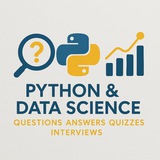Q: How can you simulate basic human-like behavior in a simple program using Python?
Imagine a chatbot that responds to user inputs with random, yet plausible, replies—mimicking how people react in conversations. For beginners, this involves using
This simulates basic human-like interaction by matching keywords and responding randomly from predefined lists. It’s a foundational step toward more advanced behavioral simulation.
#Python #BeginnerProgramming #Chatbot #HumanBehaviorSimulation #CodeExample
By: @DataScienceQ 🚀
Imagine a chatbot that responds to user inputs with random, yet plausible, replies—mimicking how people react in conversations. For beginners, this involves using
random module to generate responses based on keywords. Here’s a simple example:import random
responses = {
"hello": ["Hi there!", "Hello!", "Hey!"],
"how are you": ["I'm good, thanks!", "Doing well!", "Pretty great!"],
"bye": ["Goodbye!", "See you later!", "Bye!"]
}
def chatbot():
while True:
user_input = input("You: ").lower()
if user_input == "quit":
print("Bot: Goodbye!")
break
for key in responses:
if key in user_input:
print(f"Bot: {random.choice(responses[key])}")
break
else:
print("Bot: I don't understand. Can you rephrase?")
chatbot()
This simulates basic human-like interaction by matching keywords and responding randomly from predefined lists. It’s a foundational step toward more advanced behavioral simulation.
#Python #BeginnerProgramming #Chatbot #HumanBehaviorSimulation #CodeExample
By: @DataScienceQ 🚀
Q: How can reinforcement learning be used to simulate human-like decision-making in dynamic environments? Provide a detailed, advanced-level code example.
In reinforcement learning (RL), agents learn optimal behaviors through trial and error by interacting with an environment. To simulate human-like decision-making, we use deep reinforcement learning models like Proximal Policy Optimization (PPO), which balances exploration and exploitation while adapting to complex, real-time scenarios.
Human behavior involves not just reward maximization but also risk aversion, social cues, and emotional responses. We can model these using:
- State representation: Include contextual features (e.g., stress level, past rewards).
- Action space: Discrete or continuous actions mimicking human choices.
- Reward shaping: Incorporate intrinsic motivation (e.g., curiosity) and extrinsic rewards.
- Policy networks: Use neural networks to approximate policies that mimic human reasoning.
Here’s a Python example using
This simulation captures how humans balance risk, emotion, and social context in decisions. The model learns to adapt its strategy over time—mimicking cognitive flexibility.
#ReinforcementLearning #DeepLearning #HumanBehaviorSimulation #AI #MachineLearning #PPO #Python #AdvancedAI #RL #NeuralNetworks
By: @DataScienceQ 🚀
In reinforcement learning (RL), agents learn optimal behaviors through trial and error by interacting with an environment. To simulate human-like decision-making, we use deep reinforcement learning models like Proximal Policy Optimization (PPO), which balances exploration and exploitation while adapting to complex, real-time scenarios.
Human behavior involves not just reward maximization but also risk aversion, social cues, and emotional responses. We can model these using:
- State representation: Include contextual features (e.g., stress level, past rewards).
- Action space: Discrete or continuous actions mimicking human choices.
- Reward shaping: Incorporate intrinsic motivation (e.g., curiosity) and extrinsic rewards.
- Policy networks: Use neural networks to approximate policies that mimic human reasoning.
Here’s a Python example using
stable-baselines3 for PPO in a custom environment simulating human decision-making under uncertainty:import numpy as np
import gymnasium as gym
from stable_baselines3 import PPO
from stable_baselines3.common.vec_env import DummyVecEnv
from stable_baselines3.common.evaluation import evaluate_policy
# Define custom environment
class HumanLikeDecisionEnv(gym.Env):
def __init__(self):
super().__init__()
self.action_space = gym.spaces.Discrete(3) # [0: cautious, 1: neutral, 2: bold]
self.observation_space = gym.spaces.Box(low=-100, high=100, shape=(4,), dtype=np.float32)
self.state = None
self.reset()
def reset(self, seed=None, options=None):
self.state = np.array([np.random.uniform(-50, 50), # current reward
np.random.uniform(0, 10), # risk tolerance
np.random.uniform(0, 1), # social influence
np.random.uniform(-1, 1)]) # emotion factor
return self.state, {}
def step(self, action):
# Simulate human-like response based on action
reward = 0
if action == 0: # Cautious
reward += self.state[0] * 0.8 - np.abs(self.state[1]) * 0.5
elif action == 1: # Neutral
reward += self.state[0] * 0.9
else: # Bold
reward += self.state[0] * 1.2 + np.random.normal(0, 5)
# Update state with noise and dynamics
self.state[0] = np.clip(self.state[0] + np.random.normal(0, 2), -100, 100)
self.state[1] = np.clip(self.state[1] + np.random.uniform(-0.5, 0.5), 0, 10)
self.state[2] = np.clip(self.state[2] + np.random.uniform(-0.1, 0.1), 0, 1)
self.state[3] = np.clip(self.state[3] + np.random.normal(0, 0.2), -1, 1)
done = np.random.rand() > 0.95 # Random termination
return self.state, reward, done, False, {}
# Create environment
env = DummyVecEnv([lambda: HumanLikeDecisionEnv])
# Train PPO agent
model = PPO("MlpPolicy", env, verbose=1, n_steps=128)
model.learn(total_timesteps=10000)
# Evaluate policy
mean_reward, std_reward = evaluate_policy(model, env, n_eval_episodes=10)
print(f"Mean reward: {mean_reward:.2f} ± {std_reward:.2f}")
This simulation captures how humans balance risk, emotion, and social context in decisions. The model learns to adapt its strategy over time—mimicking cognitive flexibility.
#ReinforcementLearning #DeepLearning #HumanBehaviorSimulation #AI #MachineLearning #PPO #Python #AdvancedAI #RL #NeuralNetworks
By: @DataScienceQ 🚀
❤2
